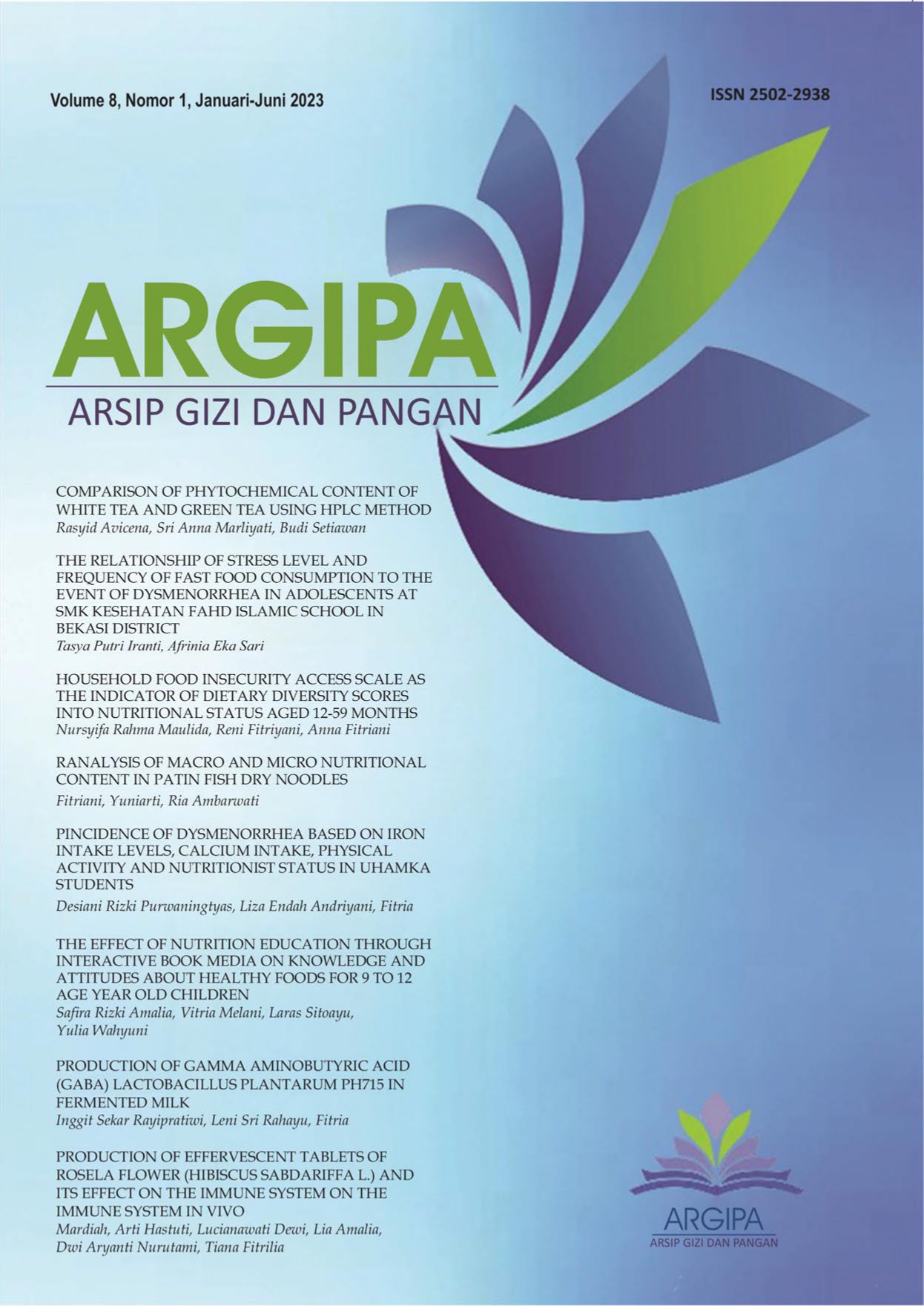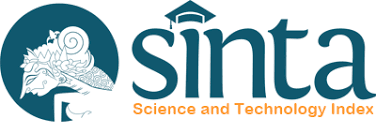Household food insecurity access scale as the indicator of dietary diversity scores into nutritional status aged 12-59 months
DOI:
https://doi.org/10.22236/argipa.v8i1.11893Keywords:
Children aged 12-59 months, Dietary Diversity Scores, Food Security, Nutritional StatusAbstract
The government of Indonesia is targeting an integrated reduction in nutrition problems. Household food security as one of the indicators of nutritional fulfillment in children both in quantity and quality is an interesting issue to see its relationship. This study aimed to see the relationship between food security and dietary diversity on the nutritional status of children aged 12-59 months in Cibaliung subdistrict, Pandeglang. The cross-sectional study was the design, and 98 children were selected purposively to be the sample. Household Food Insecurity Access Scale (HFIAS) was used to classify households in food security conditions. The two non-consecutive days of 24-hour recall method was used to obtain and classify dietary diversity scores based on WHO indicator. Data on nutritional status was obtained by measuring body weight and length/height as assessed by the z-score including Weight for Age, Height for Age, and Weight for Height z-score. The Chi-square test and Spearman Rank were used to see the relationship between variables. The result showed that the proportion of underweight is 27.6%, stunting is 44.9%, and wasting is 13.3%. There was a significant correlation between food security, and all indexed (p,0.05), WFA (r=0.491), HFA (r=0.416), and WFH (r=0.291). Other results showed the association between dietary diversity and nutritional status of WFA and WFH (p<0.05). The availability of food in the household is a determinant of fulfilling the intake which determines the nutritional status. So that, the interventions are needed to require the intake of children starting from the availability of food at the household level.Downloads
References
TNP2K. (2017). 100 kabupaten/kota prioritas untuk intervensi anak kerdil (Stunting). Jakarta Pusat: Sekretariat Wakil Presiden Republik Indonesia.
Maulida, NR., Rachmalina, R., dan Ermayani, E. (2018) Peningkatan Asupan Makan Beraneka Ragam pada Anak Usia 6-23 bulan Guna Mencapai Status Gizi Baik dan Pencegahan Stunting di Indonesia. Prosiding WNPG XI.
El Bilbeisi, A. H., Al-Jawaldeh, A., Albelbeisi, A., Abuzerr, S., Elmadfa, I., & Nasreddine, L. (2022). Households' Food Insecurity and Their Association With Dietary Intakes, Nutrition-Related Knowledge, Attitudes and Practices Among Under-five Children in Gaza Strip, Palestine. Frontiers in public health, 10, 808700. https://doi.org/10.3389/fpubh.2022.808700
Shively, G., & Evans, A. (2021). Dietary Diversity in Nepal: A Latent Class Approach. Food and nutrition bulletin, 42(2), 259–273. https://doi.org/10.1177/0379572121998121.
Kementrian Kesehatan RI. (2018). Riset Kesehatan Dasar. Jakarta: Badan Penelitian dan Pengembangan Kesehatan Kementerian Kesehatan RI.
Kementrian Kesehatan RI. (2018). Laporan Nasional Riset Kesehatan Dasar (Riskesdas)’, in. Available at: http://labdata.litbang.kemkes.go.id/images/download/laporan/RKD/2018/Laporan_Nasional_RKD2018_FINAL.pdf.
United Nations International Children's Emergency Fund. (2019). ‘Malnutrition Prevalence Remains Alarming’. Website : https://data.unicef.org/ topic/nutrition/malnutrition/.
WHO (2012) ‘Interpretation Guide’, in Nutrition Landacape Information System (NLIS). WHO Library Cataloguing. doi: 10.1159/000362780.Interpretation.
Peraturan Presiden Republik Indonesia. (2021). Perpres RI Nomor 72 tahun 2021 tentang Percepatan Penurunan Stunting.
RPJMN (2020) Peraturan Presiden Republik Indonesia Nomor 18 Tahun 2020 Tentang Rencana Pembangunan Jangka Menengah Nasional 2020-2024, Rencana Pembangunan Jangka Menengah Nasional 2020-2024. Available at: https://www.bappenas.go.https//www.twcahyono.com/2020/08/skor-pola-pangan-harapan.html?m=1.
Arlius, A., Sudargo, T., dan Subejo. (2017). Hubungan Ketahanan Pangan Keluarga dengan Status Gizi Balita (Studi di Desa Palasari dan Puskesmas Kecamatan Legok, Kabupaten Tangerang). Jurnal Ketahanan Nasional, Vol.23, No.3, Desember 2017: 359-375.
Abu-Fatima, O., Abbas, A. A. G., Racalbuto, V., Smith, L., & Pizzol, D. (2020). Child Undernutrition in Sudan: The Social and Economic Impact and Future Perspectives. The American journal of tropical medicine and hygiene, 104(3), 1149–1152. https://doi.org/10.4269/ajtmh.20-1251
Abimibayo Adeoya, A., Sasaki, H., Fuda, M., Okamoto, T., & Egawa, S. (2022). Child Nutrition in Disaster: A Scoping Review. The Tohoku journal of experimental medicine, 256(2), 103–118. https://doi.org/10.1620/tjem.256.103
FAO (2010) Guidelines For Measuring Household And Individual Dietary Diversity, Fao. doi: 613.2KEN.
FANTA (2006) ‘Household Dietary Diversity Score (HDDS) for Measurement of Household Food Access: Indicator Guide Version 2’, in Food and Nutrition Technical Assistance. Agency for International Development (USAID). doi: 10.1017/CBO9781107415324.004
FANTA (2007) ‘Household Food Insecurity Access Scale (HFIAS) for Measurement of Food access: Indicator Guide Version 3’, in. Agency for International Development (USAID).
Ashari, C. R., Khomsan, A. and Baliwati, Y. F. (2019) ‘Validasi Hfias (Household Food Insecurity Access Scale) Dalam Mengukur Ketahanan Pangan: Kasus Pada Rumah Tangga Perkotaan Dan Perdesaan Di Sulawesi Selatan’, Penelitian Gizi dan Makanan (The Journal of Nutrition and Food Research), 42(1), pp. 11–20. doi: 10.22435/pgm.v42i1.2417.
WHO (2010) ‘Indicators For Assessing Infant and Young Child Feeding Practices’, World Health Organization and the United Nations Children’s Fund (UNICEF). Available at: http://apps.who.int/iris/bitstream/handle/10665/44306/9789241599290_eng.pdf?sequence=1%0Ahttp://whqlibdoc.who.int/publications/2008/9789241596664_eng.pdf%5Cnhttp://www.unicef.org/programme/breastfeeding/innocenti.htm%5Cnhttp://innocenti15.net/declaration.
Permenkes RI (2020) ‘Standar Antropometri Anak’, in. Available at: http://repositorio.unan.edu.ni/2986/1/5624.pdf.
BKP Kementerian Pertanian (2020) Direktori Perkembangan Konsumsi Pangan. Available at: www.stpp-malang.ac.id.
Badan Ketahanan Pangan Kementerian Pertanian (2019) Kebijakan Strategis Ketahanan Pangan dan Gizi 2020-2024.
Palanivelu, G. (2017) Hubungan Keragaman Konsumsi Pangan Dengan Status Gizi Pada Balita di Lingkungan VII Desa Bagan Deli, Belawan tahun 2017. Universitas Sumatera Utara. Available at: http://repositori.usu.ac.id/handle/123456789/3803.
Utami, N. H. and Mubasyiroh, R. (2020) ‘Keragaman Makanan Dan Hubungannya Dengan Status Gizi Balita: Analisis Survei Konsumsi Makanan Individu (SKMI)’, Journal of The Indonesian Nutrition Association, 43(1), pp. 37–48. doi: 10.36457/gizindo.v43i1.467.
Berra, W. G. (2020) ‘Household Food Insecurity Predicts Childhood Undernutrition: A Cross-Sectional Study in West Oromia (Ethiopia)’, Journal of Environmental and Public Health, 2020, pp. 1–9. doi: 10.1155/2020/5871980.
Maitra, C. et al. (2017) ‘Household Food Insecurity and Maternal and Child Undernutrition : The Case of Maharashtra University of Queensland , Australia Vani Sethi United Nations Children Fund India Country Office , India Indian Institute of Population Sciences , India The Austral’, Conference on Experience and Challenges in Measuring Income, Inequality, and Poverty in South Asia.
Septiani, A. (2017) Sensitivitas dan Spesifisitas Dietary Diversity Score (DDS) Dalam Mengestimasi Tingkat Kecukupan Zat Gizi Pada Balita Usia 24-59 Bulan di Indonesia. Universitas Islam Negeri Syarif Hidayatullah. Available at: http://repository.uinjkt.ac.id/dspace/handle/123456789/35093.
Wirawan, N. N. and Rahmawati, W. (2016) ‘Ketersediaan dan Keragaman Pangan Serta Tingkat Ekonomi Sebagai Prediktor Status Gizi Balita’, Journal of Human Nutrution, 3(1), pp. 80–90.
Priawantiputri, W. and Aminah, M. (2020) ‘Keragaman Pangan dan Status Gizi Pada Anak Balita di Kelurahan Pasirkaliki Kota Cimahi’, Jurnal Sumberdaya Hayati, 6(2), pp. 40–46. doi: 10.29244/jsdh.6.2.40-46.
Kemenkes RI (2018) ‘Buku Saku Pemantauan Status Gizi Tahun 2017’, in Buku saku pemantauan status gizi tahun 2017.
Bukania, Z. N. et al. (2014) ‘Food Insecurity and Not Dietary Diversity is a Predictor of Nutrition Status in Children within Semiarid Agro-Ecological Zones in Eastern Kenya’, Journal of Nutrition and Metabolism, 2014, pp. 1–9. doi: 10.1155/2014/907153.
Rachmayanti, H., Safitri, D.E., dan Maulida, NR. (2021) Analisis Kelompok Makanan (Dietary Diversity Scores) pada Remaja usia 10-19 tahun (Studi Literatur). Jurnal Pangan Kesehatan dan Gizi, Vol 2 No.1. https://doi.org/10.54771/jakagi.v2i1.213
Mahmudiono, T. et al. (2018) ‘Household Food Insecurity as a Predictor of Stunted Children and Overweight/Obese Mothers (SCOWT) in Urban Indonesia’, Nutrients, 10(5). doi: 10.3390/nu10050535.
Jayarni, D. E. and Sumarmi, S. (2018) ‘Hubungan Ketahanan Pangan dan Karakteristik Keluarga dengan Status Gizi Balita Usia 2 – 5 Tahun (Studi di Wilayah Kerja Puskesmas Wonokusumo Kota Surabaya)’, Amerta Nutrition, 2(1), pp. 44–51. doi: 10.20473/amnt.v2i1.2018.44-51.
Verawati, B., Afrinis, N. and Yanto, N. (2021) ‘Hubungan Asupan Protein Dan Ketahanan Pangan Dengan Kejadian Stunting Pada Balita Di Masa Pendemi COVID 19’, PREPOTIF : Jurnal Kesehatan Masyarakat, 5(1), pp. 415–423. doi: 10.31004/prepotif.v5i1.1586.
Wardani, D. W. S. R., Wulandari, M. and Suharmanto (2020) ‘Hubungan Faktor Sosial Ekonomi dan Ketahanan Pangan terhadap Kejadian Stunting pada Balita’, Jurnal Kesehatan, 10(2), pp. 287–293. doi: 10.26630/jk.v11i2.2230.
Riski, H., Mundiastutik, L. and Adi, A. C. (2019) ‘Ketahanan Pangan Rumah Tangga, Kejadian Sakit dan Sanitasi Lingkungan Berhubungan dengan Status Gizi Balita Usia 1-5 Tahun di Surabaya’, Amerta Nutrition, 3(3), pp. 130–134. doi: 10.2473/amnt.v3i3.2019.130-134.

















